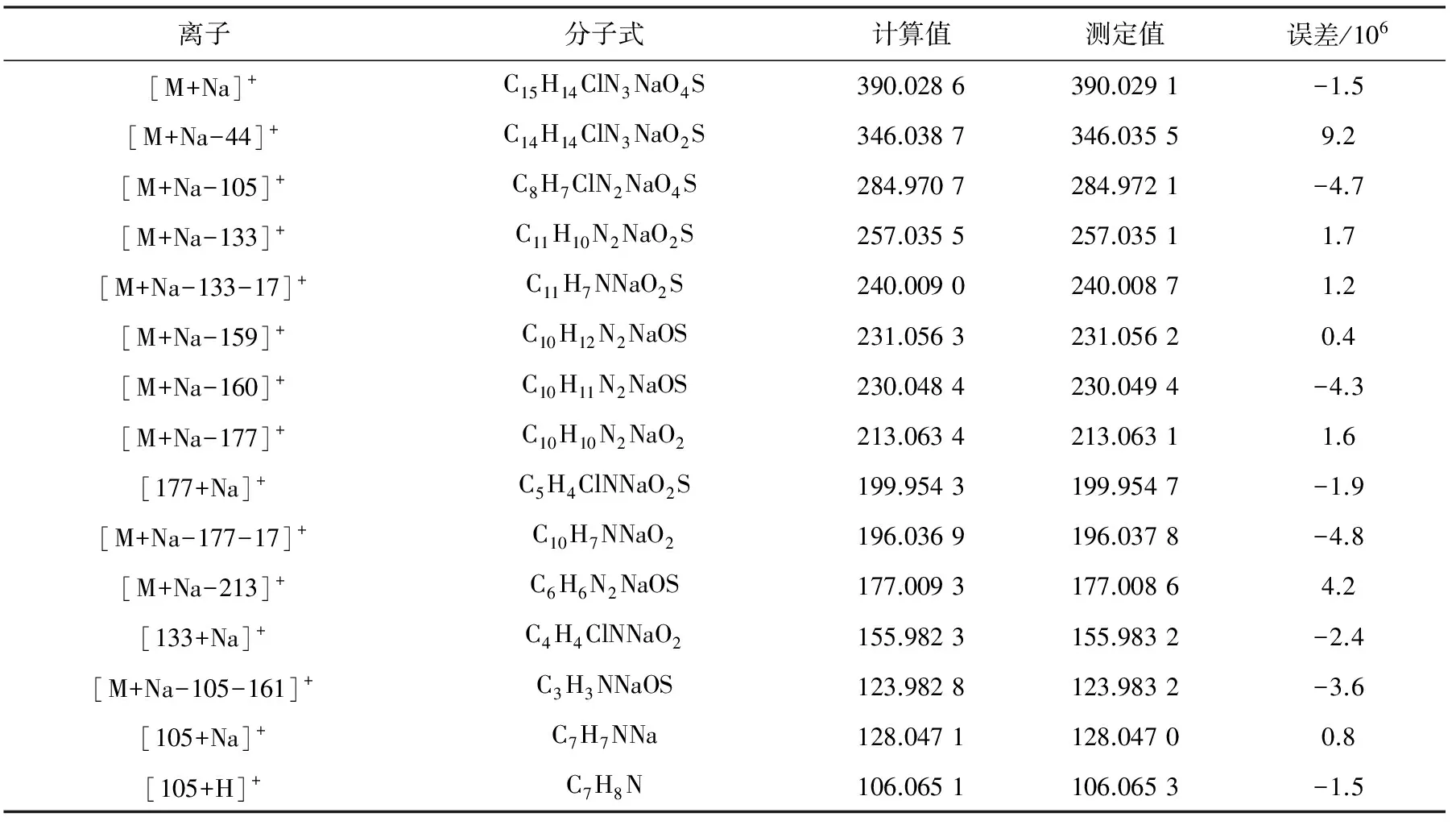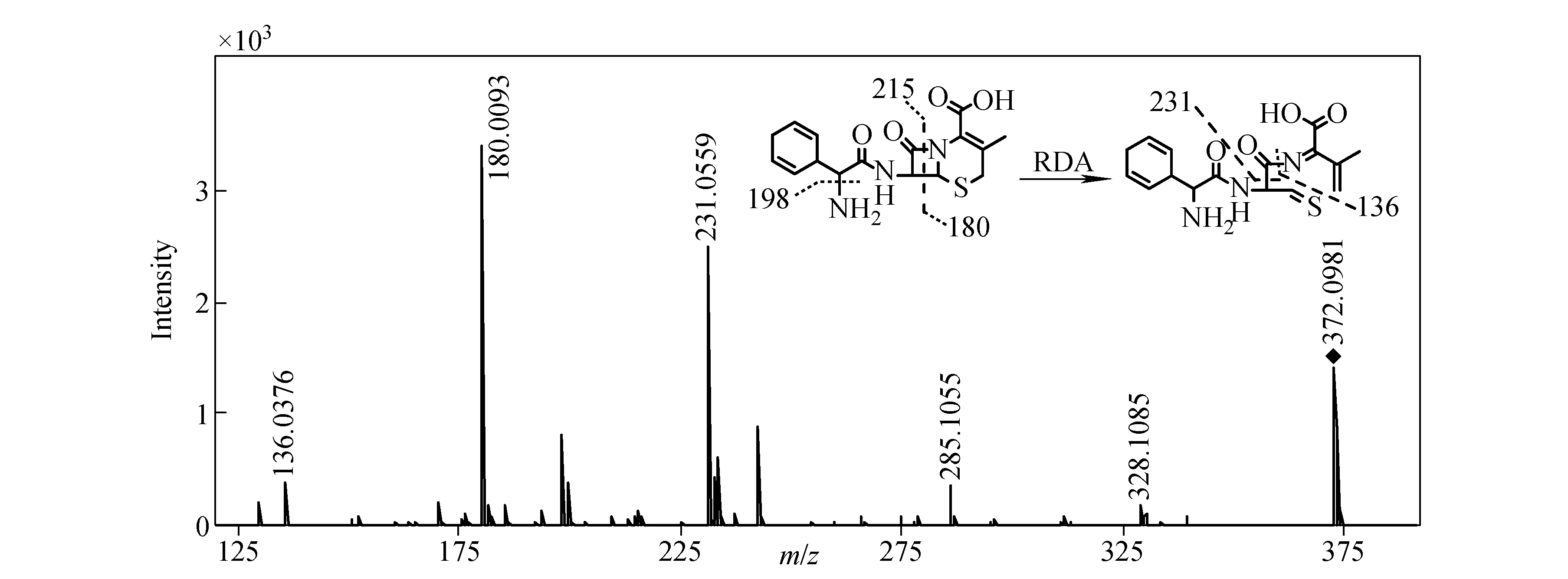β-内酰胺类抗生素质谱裂解机理研究
2014-07-25郭泽琴霍佳丽王建华吴志军
郭泽琴,霍佳丽,王建华,吴志军
(1. 重庆大学生物工程学院, 重庆 400044;2. 中国科学院成都生物研究所, 四川 成都 610041)
β-内酰胺类抗生素质谱裂解机理研究
郭泽琴1,霍佳丽1,王建华1,吴志军2
(1. 重庆大学生物工程学院, 重庆 400044;2. 中国科学院成都生物研究所, 四川 成都 610041)
采用电喷雾-四极杆-飞行时间串联质谱(ESI-Q-TOF-MS/MS)对3种头孢类和2种青霉素类药物的[M+Na]+裂解规律进行研究。头孢类药物[M+Na]+裂解可产生许多互补的碎片离子,1,3-H重排和retro-Diels-Alder (RDA)是其重要的裂解方式;青霉素类药物[M+Na]+裂解除了一些常规的中性分子丢失外,在氘代实验的基础上提出了比以往更合理的H2S丢失途径,即1,5-H重排。本实验丰富了β-内酰胺类药物的质谱裂解途径,对应用质谱技术快速鉴定复杂体系中β-内酰胺类抗生素具有重要作用。
β-内酰胺类抗生素;电喷雾-四极杆-飞行时间串联质谱(ESI-Q-TOF-MS/MS);裂解规律;氢重排
β-内酰胺类药物是使用最早的一类抗生素,在临床和畜牧业中被广泛用于疾病的预防和治疗。在速成养殖中,β-内酰胺类药物作为饲料添加剂可以促进牲畜的生长[1-8],但该类药物在食用动物组织中容易残留。随着抗生素的过度使用,动物体内抗生素残留量增加,长期食用含有β-内酰胺类抗生素残留的食品,可对人体造成严重的危害[2-4]。因此,需要一种快速、有效的方法对食品中β-内酰胺类抗生素进行有效的检测和监控。
质谱分析具有检测速度快、灵敏度高和样品耗费少等优点,已成为复杂体系中痕量成分分析的一种重要方法[18-19]。质谱鉴定工作的可靠性需要丰富的带有结构信息的碎片离子来保证。对质子加合的β-内酰胺类药物的质谱研究已有一些报道,其主要的裂解方式为β-内酰胺环和碳氮键的断裂[8-17],但关于该类抗生素钠加合离子[M+Na]+的断裂方式却未见报道。本工作利用高分辨电喷雾-四极杆-飞行时间串联质谱 (ESI-Q-TOF-MS/MS)法研究5种具有代表性的β-内酰胺类药物(包括3种头孢类药物和2种青霉素类药物) [M+Na]+的断裂方式,其结构式示于图1,并且利用氘代实验对其断裂机理进行验证。

注:1.头孢克洛;2.头孢拉啶;3.头孢羟氨苄;4.氨苄西林;5.阿莫西林图1 5种β-内酰胺类抗生素的结构式 Fig.1 The structure of five kinds of β-lactam antibiotics
1 实验部分
1.1主要仪器和装置
microTOF Q质谱仪:德国Bruker公司产品,配有电喷雾(ESI)离子源,Compass 数据处理系统,自动进样器。
1.2试剂和样品
β-内酰胺类抗生素对照品:美国Sigma-Aldrich公司产品;甲醇(色谱纯):美国Fisher Scientific公司产品;质谱校正液:美国Agilent公司产品;实验用水:自制超纯水;氘代试剂D2O和CD3OD:美国CIL公司产品;氘代溶液配制:分别取0.1 mg头孢克洛(1)、头孢拉定(2)和氨苄西林(4)于2 mL D2O中,放置24 h。
1.3质谱条件
电喷雾(ESI)离子源;ESI源电压-500 V;毛细管电压-4 500 V;雾化气体:高纯氮气;雾化气压力30 kPa;进样速度180 μL/h;干燥气温度180 ℃;干燥气流速4.0 L/min;在正离子模式下先进行一级质谱全扫描,m/z100~3 000,再选择[M+Na]+离子进行二级质谱分析。
2 结果与讨论
2.1头孢类抗生素1~3的[M+Na]+MS/MS分析及裂解规律研究
对头孢克洛(1)[M+Na]+m/z390进行二级质谱分析,可以得到丰富的碎片离子峰,示于图2,其主要碎片离子组成列于表1。互补离子对m/z213和m/z200为β-内酰胺环断裂产生的离子峰,m/z213再丢失一分子NH3生成m/z196;互补离子对m/z257和m/z156由[M+Na]+发生RDA反应产生中间体m/z390经氨交换和四元环氢重排而得到,m/z257再脱去一分子NH3得到m/z240,该中间体也可经酯化反应和麦氏重排[20]生成m/z231,或直接发生自由基断裂生成m/z230;互补离子对m/z285和m/z128由[M+Na]+经1, 3-H重排而得到,前者再经RDA反应,进一步断裂生成m/z124,其裂解途径经氘代实验得到验证,示于图2b。头孢克洛(1) [M+Na]+可能的断裂过程示于图3,化合物2、3[M+Na]+的裂解途径与化合物1相似,示于图4。

注:a.[M+Na]+二级质谱图;b.[M/D+Na]+ 二级质谱图;c.氘代试验一级扫描图图2 头孢克洛(1)[M+Na]+ m/z 390的二级质谱图Fig.2 Product ion scan of the selected precursor [M+Na]+ at m/z 390 for cefaclor (1)

表1 头孢克洛(1)主要碎片离子的组成

图3 头孢克洛(1) [M+Na]+ 可能的断裂过程Fig.3 Major fragmentation patterns of [M+Na]+ for cefaclor (1)

图 4 头孢拉啶(2) [M+Na]+ 的二级质谱图Fig.4 Product ion scan of the selected precursor [M+Na]+ for cefradine (2)
2.2青霉素类抗生素4~5的[M+Na]+MS/MS分析及裂解规律研究
氨苄西林4[M+Na]+m/z372的MS/MS图示于图5,其主要碎片离子组成列于表2。例如,互补离子对m/z267和m/z128由m/z372经1, 3-H重排而得到。m/z372可丢失一分子CO产生m/z344,后者再脱去一分子CO2和H2S产生m/z266;还可连续脱去一分子NH3,CO2和H2S生成m/z277,其中H2S易通过1, 5-H重排而脱去,氨苄西林(4) [M+Na]+可能的断裂过程示于图6,该裂解途径经氘代实验得以确证(图5b),并且从氘代裂解图中可以推断出S元素是以DHS或D2S的形式丢失的。阿莫西林(5) [M+Na]+的裂解途径与氨苄西林(4)相似,其二级质谱图示于图7。
与[M+H]+相比,β-内酰胺类药物的[M+Na]+裂解途径更丰富,可产生酰胺交换,四氢重排,1, 3、1, 5-H重排以及RDA反应等裂解途径。可能的原因是质子化位点不同,在质谱中H+倾向于与氮结合发生电荷诱导裂解,而Na+更倾向于与氧结合。

注:a.[M+Na]+二级质谱图;b.[M/D+Na]+二级质谱图; c.氘代试验一级扫描图图5 氨苄西林(4)m/z 372的二级质谱图 Fig.5 Product ion scan of the selected precursor [M+Na]+ at m/z 372 for ampicillin (4)

表2 氨苄西林(4)主要碎片离子的组成
3 结论
本实验采用高分辨ESI-Q-TOF-MS/MS在正离子模式下对5种β-内酰胺类抗生素[M+Na]+二级质谱的裂解规律进行分析研究,并在氘代实验的基础上,解释了这类化合物的裂解过程,提出了1, 3、1, 5-H重排以及RDA反应等裂解机理,丰富了离子化学机理,为使用质谱技术快速鉴定复杂体系中非目标β-内酰胺类药物提供了理论基础。

图6 氨苄西林(4) [M+Na]+ 可能的断裂过程Fig.6 Major fragmentation patterns of [M+Na]+ for ampicillin (4)

图7 阿莫西林(5) [M+Na]+ 的二级质谱图Fig.7 Product ion scan of the selected precursor [M+Na]+ at m/z 388 for amoxicillin (5)
[1] SERRANO J M, SILVA M. Use of SDS micelles for improving sensitivity, resolution, and speed in the analysis of beta-lactam antibiotics in environmental waters by SPE and CE[J]. Electrophoresis, 2007, 28(18): 3 242-3 249.
[2] 黄炎坤, 程 璞. 从“速成鸡”事件反思我国肉鸡安全生产[J].中国畜牧杂志, 2013, 49(2): 47-49. HUANG Yankun, CHENG Pu. From the "instant chicken" event reflect the poultry production safety in our country[J]. Chinese Journal of Animal Science, 2013, 49(2): 47-49(in Chinese).
[3] GHIDINIY S, ZANARDIY E, VARISCOZ G, et al. Residues ofβ-lactam antibiotics in bovine milk:Confirmatory analysis by liquid chromatography tandem mass spectrometry after microbial assay screening[J]. Food Additives and Contaminants, 2003, 20(6): 528-534.
[4] REZENDE C P, ALMEIDAA M P, BRITOA R B, et al. Optimisation and validation of a quantitative and confirmatory LC-MS method for multi-residue analyses ofβ-lactam and tetracycline antibiotics in bovine muscle[J]. Food Additives and Contaminants, 2012, 29(4): 541-549.
[5] KANTIANI L, FARRE M, BARCELO D. Analytical methodologies for the detection ofβ-lactam antibiotics in milk and feed samples[J]. Trends in Analytical Chemistry, 2009, 28(6): 729-744.
[6] PETROVIC J M, KATIC V R, BUGARSKI D D. Comparative examination of the analysis ofβ-lactam antibiotic residues in milk by enzyme, receptor-enzyme, and inhibition procedures[J]. Food Analytical Methods, 2008, 1(2): 119-125.
[7] GHIDINIY S, ZANARDIY E, VARISCOZ G, et al. Residues ofβ-lactam antibiotics in bovine milk: Confirmatory analysis by liquid chromatography tandem mass spectrometry after microbial assay screening[J]. Food Additives and Contaminants, 2003, 20(6): 528-534.
[8] CHA J M, YANG S, CARLSON K H. Trace determination ofβ-lactam antibiotics in surface water and urban wastewater using liquid chromatography combined with electrospray tandem mass spectrometry[J]. Journal of Chromatography A, 2006, 1 115(1): 46-57.
[9] TENCONI S, DE FILIPPO L, DA COL M, et al. Electrospray mass spectrometry in the structural characterization of cephalosporins[J]. Journal of Mass Spectrometry, 1999, 34(4): 268-275.
[10] RABBOLINI S, VERARDO E, DA COL M, et al. Negative ion electrospray ionization tandem mass spectrometry in the structural characterization of penicillin[J]. Rapid Communications in Mass Spectrometry, 1998, 12(22): 1 820-1 826.
[11] HELLER D N, NGOH M A. Electrospray ionization and tandem ion trap mass spectrometry for the confirmation of seven beta-lactam antibiotics in bovine milk[J]. Rapid Communication in Mass Spectrometry, 1998, 12(24): 2 031-2 041.
[12] 朱 侃, 陈小青, 马 超, 等. 头孢克洛结构测定与分析[J]. 药物分析杂志, 2010, 30(11): 2 111-2 115. ZHU Kai, CHEN Xiaoqing, MA Chao, et al. Determination and analyze the structure of cefaclor[J]. Journal of Pharmaceutical Analysis, 2010, 30(11): 2 111-2 115 (in Chinese).
[13] 郑 岩, 王英武, 周 慧, 等. 电喷雾四级杆飞行时间质谱法在分析青霉素类药物负离子裂解规律中的应用[J]. 分析化学, 2004,32(2): 183-186. ZHENG Yan, WANG Yingwu, ZHOU Hui, et al. Negative ion cleavage rule analysis of penicillins using electrospray ionization-quadropole time-of-flight mass spectrometry[J]. Chinese Journal of Analytical Chemistry, 2004,32(2): 183-186 (in Chinese).
[14] HELLER D N, KAPLAN D A, RUMMEL N G, et al. Identification of cephapirin metabolites and degradants in bovine milk by electrospray ionization-ion trap tandem mass spectrometry[J]. Journal of Agricultural and Food Chemistry, 2000, 48(12): 6 030-6 035.
[15] WU C S, ZHANG J L, QIAO Y L, et al. Simultaneous determination of 14 beta-lactam antibiotics in cosmetic products by liquid chromatography tandem mass spectrometry method[J]. Chinese Chemical Letters, 2011, 22(3): 334-337.
[16] GOOLSBY B J, BRODBELT J S. Characterization ofβ-lactams by photodissociation and collision-activated dissociation in a quadrupole ion trap[J]. Journal of Mass Spectrometry, 1998, 33(8): 705-712.
[17] CHEN J, ZHAO X J, FRISTSCHE J, et al. Practical approach for the identification and isomer elucidation of biomarkers detected in a metabonomic study for the discovery of individuals at risk for diabetes by integrating the chromatographic and mass spectrometric information[J]. Analytical Chemistry, 2008, 80(4): 1 280-1 289.
[18] 于林芳, 徐 杰, 陈士国, 等. 仿刺参皂苷类化合物的电喷雾负离子质谱裂解规律研究[J].质谱学报, 2011, 32(2): 77-81. YU Linfang, XU Jie, CHEN Shiguo, et al. Study on the fragmentation pathways of triterpene glycosides from apost ichopus japonicus selenka by negative electrospray ionization mass spectrometry[J]. Journal of Chinese Mass Spectrometry Society, 2011, 32(2): 77-81(in Chinese).
[19] WU Z J, HAN D, CHEN X Z, et al. Analysis of benzofuran derivatives using electrospray ionization ion trap and electrospray ionization quadrupole time-of-light mass spectrometry[J]. Rapid Communication in Mass Spectrometry, 2010, 24(8): 1 211-1 215.
[20] WU Z J, PU J X, LI L M, et al. Electrospray tandem mass spectrometry of longipedlactone triterpenoids[J]. Journal of Mass Spectrometry, 2010, 45(4): 451-455.
StudyontheCleavageRuleofβ-LactamAntibioticsbyElectrosprayQuadrupoleTime-of-FlightTandemMassSpectrometry
GUO Ze-qin1, HUO Jia-li1, WANG Jian-hua1, WU Zhi-jun2
(1.CollegeofBioengineering,ChongqingUniversity,Chongqing400044,China; 2.ChengduInstituteofBiology,ChineseAcademyofSciences,Chengdu610041,China)
The fragmentation of sodiated molecules [M+Na]+of five kinds ofβ-Lactam antibiotics, including three cephalosporins and two penicillins, were studied by electrospray quadrupole time-of-flight tandem mass spectrometry (ESI-Q-TOF-MS/MS). For cephalosporins, besides the cleavage of active tetracycle, 1, 3-H rearrangement and retro-Diels-Alder reaction (RDA) played the substantial roles in the production of many informative product ions, and the D-labeling experiments supported the postulated mechanisms.The processes of sequential losses of a CO2and H2S molecule from the precursor sodiated molecules for penicillins possibly involving 1, 5-H rearrangement were elucidated and further confirmed by D-labeling experiment. This work enriches the fragmentation ofβ-lactam antibiotics and will be valuable for the rapid identification of untargetedβ-lactam antibiotics in the complicated matrix by mass spectrometry.
β-lactam antibiotics; electrospary quadrupole time-of-flight tandem mass spectrometry (ESI-Q-TOF-MS/MS); fragmentation mechanisms; H rearrangement
2013-04-10;
:2013-07-01
郭泽琴(1989~),女(汉族),安徽人,硕士研究生,药物分析专业。E-mail: guozq1008@163.com
王建华(1962~),男(汉族),安徽人,教授,从事药物合成与分析和药物制剂工程研究。E-mail: wjh@cqu.edu.cn 吴志军(1979~),男(汉族),湖南人,青年研究员,从事药物质谱分析与测试研究。E-mail: wuzj@cib.ac.cn
O 657.63
:A
:1004-2997(2014)01-0045-07
10.7538/zpxb.2014.35.01.0045
